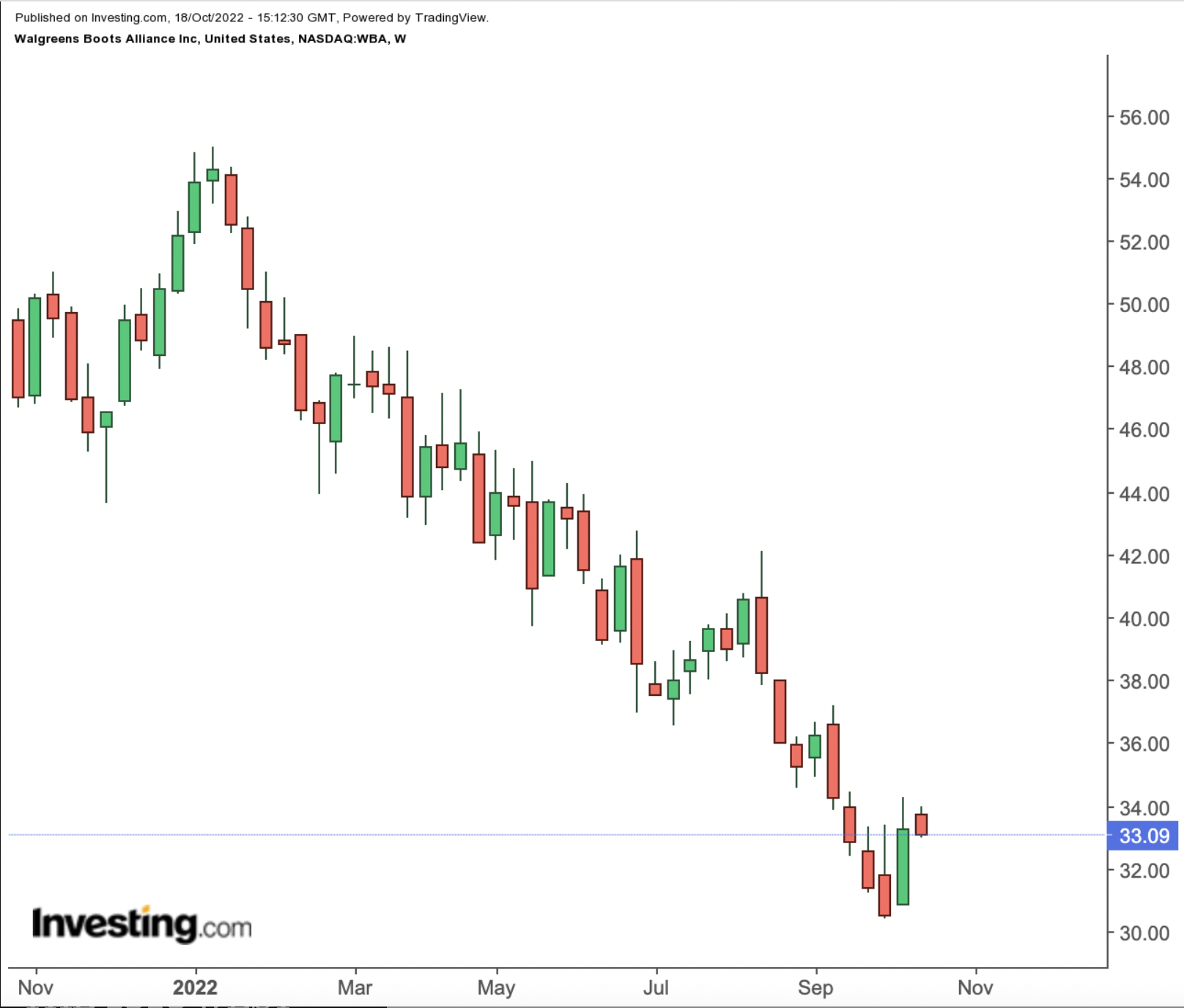- Trading at barely 7x this year's earnings per share guidance and with a 5.8% dividend yield, WBA looks like a steal
- Near-term investments are pressuring profit: if Walgreens can deliver on growth promises, stock will soar
- But that's a huge 'if'
On its face, Walgreens Boots Alliance (NASDAQ:WBA) looks like one of the best long-term opportunities created by the bear market. Based on the midpoint-of-fiscal-2023 guidance (ending August), shares trade at 7.25x earnings. Walgreens' dividend yields 5.8%, and the Dividend Aristocrat has increased its payout for nearly 50 consecutive years.
But there are reasons why Walgreens stock looks so cheap. Performance in recent years has been soft. The company's own strategy highlights the risk to the core pharmacy business.
Right now, this simply is a company heading in the wrong direction. The WBA stock price suggests the market doesn't believe a turnaround is on the horizon. There's a contrarian case for betting otherwise — but investors need to understand the bet they're making.

Source: Investing.com
The Case Against Walgreens
Right now, the market is pricing Walgreens as if it were a declining business. There's a simple reason for that: Walgreens indeed is a declining business.
With last week's fourth quarter report, Walgreens guided for FY23 adjusted earnings per share of $4.45 to $4.65. That range was modestly better than Wall Street consensus, but still implies a year-over-year decline of 8% to 12% against the $5.04 generated in fiscal 2022.
To be fair, the decline is being driven entirely by a plunge in vaccinations for COVID-19, while the stronger dollar provides another, more modest headwind. But the multi-year trajectory remains negative.
In fiscal 2018, Walgreens generated adjusted EPS of $6.02. But even the roughly 25% decline over five years doesn't tell the whole story. Stock buybacks have sharply lowered the company's share count. Adjusted operating income this year is guided to $4.5 billion to $4.6 billion — some 40% lower than the FY18 figure.
The problem is operating margins. Adjusted operating margin was 5.6% in FY18 and likely come in around 3.3% in the coming year. Lower reimbursement rates from private and public insurers, and lesser cost savings from generic drug substitutions, have crushed margins, not only for Walgreens but for rivals CVS Health (NYSE:CVS) and Rite Aid (NYSE:RAD).
Those issues aren't going away. Walgreens itself appears to understand that. The company has spent billions on acquisitions to diversify away from the retail pharmacy business. It spent more than $5 billion on a majority stake in primary care operator VillageMD, more than $2 billion for specialty pharmacy Shields, and $800 million on home-care provider CareCentrix.
Walgreens wouldn't be spending those billions if it believed in the long-term health of the retail pharmacy business. The company itself knows it needs more.
Betting On A Turnaround
That said, it's possible the plan behind the acquisitions indeed works out. Walgreens is trying to build a broader healthcare company that, particularly with VillageMD, will move into potentially more profitable areas of the industry.
And one intriguing aspect of Walgreens' valuation is that the current low multiples are coming against depressed profits. Those acquired businesses still are running at a loss: Walgreens expects an adjusted EBITDA (earnings before interest, taxes, depreciation, and amortization) loss of $220 million to $240 million this year.
That will change, and Walgreens expects those businesses will drive overall growth. On the fourth-quarter conference call, chief financial officer James Kehoe projected Walgreens would increase EPS by a mid- to high-single-digit percentage in fiscal 2024, with double-digit growth the following year. Even from that point, there’s still room for the acquired businesses — which make up the U.S. healthcare segment — to improve.
In pharmacy, meanwhile, Walgreens believes it can regain lost market share in prescriptions by improving staffing and reinstating pre-pandemic operating hours. Higher prescription counts would also drive higher visitation and, thus, increased profitable 'front-end' sales of non-prescription items.
There's a strategy here that could work. And success does suggest a potentially significant upside in Walgreens stock. The mid-term outlook suggests FY25 EPS around $5.50. Apply even a 10x multiple to that figure — about where WBA traded pre-pandemic — and with dividends, two-year total returns could exceed 70%.
A Show-Me Story
It’s tough to get too attached to that story just yet, however. Walgreens stock — almost incredibly — has declined 65% since December 2018. That entire time, management has been promising that growth is around the corner. Indeed, as one analyst noted on the Q4 conference call, guidance for FY23 is markedly low, below that implied when Walgreens gave a multi-year outlook the year before.
The challenges in pharmacy aren't going away. A strategy based on acquisitions always adds risk, and Walgreens now has a significantly leveraged balance sheet that will amplify downside if results again disappoint.
Yes, Walgreens stock looks cheap fundamentally. But it should look cheap fundamentally. Walgreens is a leveraged, declining business — and the market is not going to apply a high multiple to that kind of business. Until the trend of the business changes, the trend of the stock will stay the same.
Disclaimer: As of this writing, Vince Martin has no positions in any securities mentioned.
